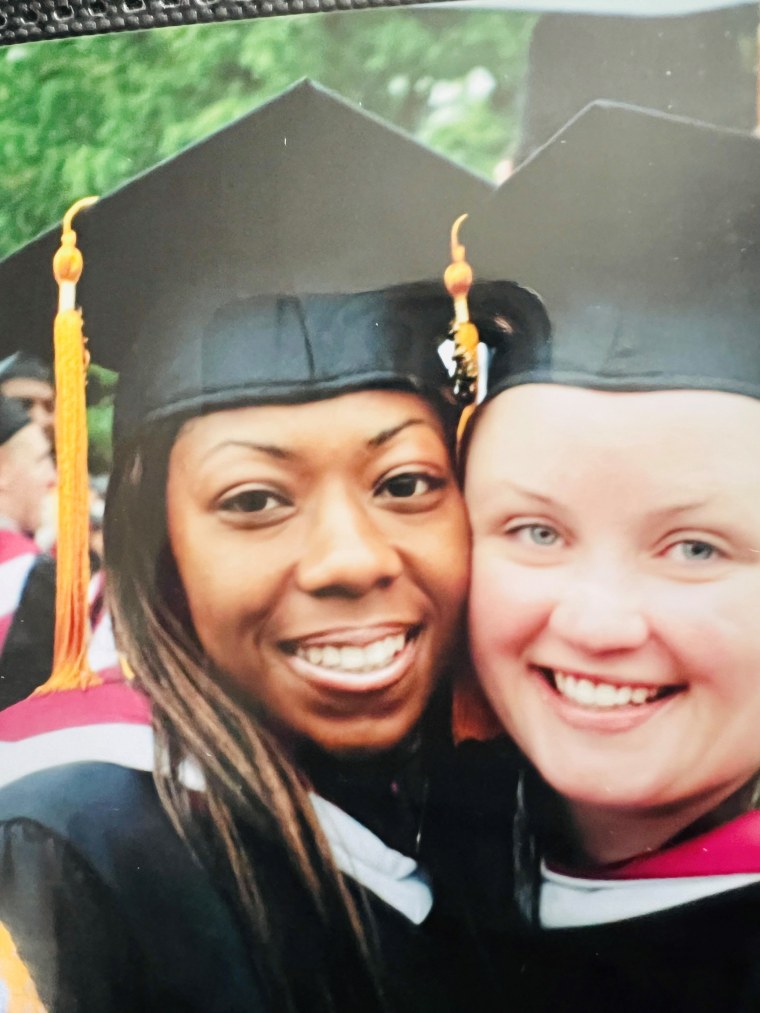When nurse Shamika Williams, then 23, heard about her coworker being stuck with a needle, she felt panicked. Soon, she was taking extra steps to make sure she stayed safe at work in the hospital.
“It was traumatic for me,” the 40-year-old from New Jersey tells TODAY.com. “I was extra cautious with everything I did. I had to put gloves on to hand out medicine cups. I started asking other nurses to start IV lines for me because I didn’t want to come into contact with blood.”
Her worries about germs expanded into the world outside work. If she saw a Band-Aid on the ground, she had a panic attack. As her worries increased, she visited her primary care doctor for answers.
“He did tell me that I had obsessive compulsive disorder, but that was it,” Williams says. “There was never any referral to a therapist, a psychologist, a psychiatrist.”
Life with obsessive compulsive disorder
As time went on after her colleague was stuck with a needle, Williams noticed her behaviors changed dramatically.
“I would constantly wash my hands while I was in the hospital to the point where they were raw,” she says. “My hands were so cracked and dry.”
After work, she threw her nursing shoes and scrubs away — she feared the germs that lived on them.
“(The) thoughts for me were so overwhelming that I couldn’t put those shoes back on,” Williams says. “I literally had a bag of scrubs, and I would put my scrubs in that bag. I would throw them away.”
She visited the mall frequently “constantly buying new things.”
“At one point in time, I had no clothes in my closet because I threw away everything,” she recalls. “Not just my hospital clothes, but also my regular, everyday clothes.”
While she knew her doctor said she had obsessive compulsive disorder (OCD), she didn’t truly understand what that meant. She went to therapy, but it never seemed to work. Her rituals to cope with her fears intensified.
“The only thing I knew to do that made me feel better was throw away whatever it was that I was wearing,” she says. “I would clean my car with bleach.”

After each cleaning spree, she’d shower for 30 minutes and then go to sleep.
“I was so exhausted,” she says. “The only comfort that I found was to go to sleep. That was the only escape from my thoughts.”
These feelings started in 2006, right after Williams had graduated from college with a nursing degree. She was still living with her parents, who worried for their daughter. That’s when she went to the doctor, but she didn’t know what to do after that appointment.
“I literally remember him saying to me, ‘If you continue down this path, you’re going to end up in a (psychiatric) hospital,’” Williams says. “I just continued trying to cope.”
Soon after, Williams quit her job at the hospital.
“I felt that not only was I putting my patients at risk, but I was putting myself at risk,” she says. “I worked so hard for that profession that I wanted to be a part of so greatly. I couldn’t do it.”
For a month, she worked in a rehabilitation facility, hoping she’d have less fear, but they returned.
“I (was) starting to fall into depression because I just went through four years of school,” she says. “I got a nursing degree that I worked so hard for, and I (had) no idea what I am supposed to do with it ... because I didn’t want to be in the hospital.”
Williams began searching for therapists to help her, but the results were mixed results. At times, she took medication and saw various professionals who tried to help, yet she never quite felt like her symptoms were being treated.
“Things did get better over the years,” she says. “But it was still very prevalent in my life.”

Then the pandemic hit. Williams already had a massive fear of germs, but an unknown airborne virus heightened her symptoms.
“If someone coughs around you, do they have COVID?” she remembers thinking. “It was the worst thing that could have happened for someone dealing with contamination OCD.”
But early on in the pandemic, in 2020, she learned about NOCD — an app that provides OCD support and teletherapy — and she signed up. For the first time since 2007, when she started seeking treatment, Williams received something called exposure and response prevention therapy (ERP). It was revolutionary for her.
What is OCD? How is it treated?
Few people understand what it's like to live with OCD, and many have only heard of it as the punchline in a joke.
“Most people think you’re checking the door locks, you’re washing your hands, or it’s kind of a personality quirk,” Patrick McGrath, Ph.D., chief clinical officer of NOCD, tells TODAY.com.
“Really it’s two things: There’s the experience of intrusive types of thoughts or images or urges that we might find to be disturbing. We feel they are inappropriate, and they create a lot of discomfort or shame or guilt or stress or anxiety. And (the second thing is) we therefore do some kind of mental act or behavior to neutralize it.”
About 2% of the population has OCD. A first-degree family member with it means a person has a 20% chance of developing it, he says.
McGrath stresses that most people who like a tidy house, for example, likely do not have OCD.
“We’ve seen it in movies and TV shows as a funny thing or just a quirky thing,” he says. “It really is debilitating for people who have it.”

For people living with OCD, exposure and response prevention therapy is one of the recommended treatments, alongside medication, according to the International OCD Foundation. It's a type of cognitive behavioral therapy, which is used to treat a range of psychological disorders.
“(ERP) has two components. ... We purposefully want to expose people to things that are uncomfortable, and we want to teach them they can handle these things,” McGrath explains. “The response prevention piece is getting people ... to not do those immediately gratifying safety behaviors that do feel good in the moment, but to allow for that discomfort to be there and learn they can handle it.”
This helps people to realize that the “feared results” won’t occur if they don’t carry out the compulsion, he says. “They learn that they don’t need to trust what the OCD tells them,” he adds.
It’s something people need to practice to master, just like any other skill. Thanks to telehealth, McGrath feels like he can work with people in their space to get better at it. Take someone who worries about whether they turned the stove off so they check it over and over. During ERP therapy, McGrath would ask them to turn the stove on and then turn it off and ignore it.
“In a virtual world, I can do the session with you while you’re at your stove, and I’m in my office,” he says. “I can have you for an entire hour practice doing the exercise right there and really getting hands-on learning with that experience.”
Research had indicated that the more someone participates in the compulsive behavior, the worse their anxiety becomes, McGrath says, adding, “The more people check things like the stove over time, actually the less confidence they have about it."
When they don’t check and everything is fine, it helps them learn new behaviors. By not checking the stove, they learn that they do know how to turn the stove off the first time, and they'll be OK.

Life with ERP therapy
Williams recently took a vacation for the first time in years. She felt free.
“ERP was the best thing that I have ever done. Not only have I regained my life, my confidence, I regained the person who I was — and better,” she says. “I still do have those ‘what if’ thoughts, but I’m able to deal with them better than having panic attacks and feeling like my whole day is over and falling into the depression.”
She’s writing a book about her experience called “OCD: The What if Factor” to share her experiences with others. She’s proud of her progress. Now, if she sees a Band-Aid or discarded mask on the sidewalk, she feels better able to cope.
“I’m able to do my ERP and just sit with it,” she says. “I may even just sit there for a minute, and it may seem weird to other people. But for me, I know what I’m doing.”
For so many years, Williams believed she would never feel better. Therapies and medications only worked so well for her, and she imagined she’d always have to struggle. After engaging in ERP therapy since 2020, she feels like she’s happier and wants to give hope to others.
“I was so not optimistic about this because I didn’t think it was going to work for me,” she says. “You’re always going to have these little relapses, but you have to keep going. You have to stick with the program.”